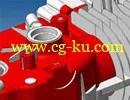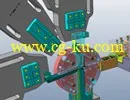
英国VISI-Series CAD/CAM 模具软件。VISI-系列在全球模具业界被公认为是世界领先的CAD/CAM解决方案.它提供了一种独特而完整的应用组合,包括线架构、曲面及实体建模,全面的2D和3D加工策略,以及专业的塑模和级进模设计工具.这是2013年最新发行的版本。

VISI 是一套完整而全面的模具业专用的先进的 CAD/CAM/CAE 解决方案. 它提供了一套独特的整合工具, 完全集成了线架构, 曲面和实体混合建模, 综合高速路径专用的 2D, 3D 和 5 轴加工策略. 此外, VISI 还涉及到日益重要的模具设计领域, 拥有全 3D 的冲模设计 (Visi-Progress), 塑模设计 (Visi-Mould) 和塑胶模流分析 (Visi-Flow) 等模块.
针对不同软件供应商间的衔接, 实体至曲面, CAD/CAM 图形转换等要求, Vero Software 提供了专门的解决方案消除传统系统的转档问题.
VISI 提供了以下模组:

VISI Modelling
VISI Modelling 是所有 VISI 产品的基础, 提供一个基于行业标准 Parasolid 核心的健全的和强大的实体和曲面建模系统.

VISI Analysis
在工程早期找出潜在的问题是非常有益的. VISI Analysis 提供了一套专业的工具来对模型进行检查和准备.

VISI Mould
VISI Mould 基于特殊的自动化行业之上, 提供了完整的塑模设计的解决方案, 引导客户完成整个的塑模开发流程.

VISI Flow
VISI Flow 是一个独特的预测工具. 产品设计, 模具制作和模具设计者将受益于使用 Vero 的专业的射出模拟, 以实现成本效益和可靠的模具设计以及最佳的成型条件.

VISI Electrode
VISI Electrode 是一种自动化模块, 用于加工和管理电极以及为精密制造而制作的电极治具, 并且努力加工塑胶模和冲压模上的特征.

VISI Progress
VISI Progress 是一种直观的工具, 用于制品分析, 3D 排料带, 以及级进模和冲压模的设计.

VISI Multi-Slides
VISI Multi-slides 是 VISI Progress 的延伸. 它被用于 “多滑块机床” 使用的凸轮设计, 及折弯工艺.

VISI Machining 2D
VISI Machining 2D 是 VISI Progress 的延伸. 它被用于 “多滑块机床” 使用的凸轮设计, 及折弯工艺.

VISI Machining 3D
VISI Machining 3D 在最复杂的 3D 制品上创建智能的刀具路径. 专注的高速铣削技术, 以平顺的运算法则建立高效率的 NC 代码.

VISI Machining 5 Axis
5 轴加工拥有许多优势, VISI Machining 为操作者提供了卓有成效的解决方案, 建立有着先进的碰撞控制的高效的刀具路径.

VISI PEPS-Wire
完全基于特征, VISI PEPS-Wire 采用了专为精密工程和模具工业研发的业界领先的 PEPS Wire 技术.

VISI Blank
VISI Blank 是一款专为冲压模具行业解决复杂 3D 形状展开成 2D 形状的解决方案.

VISI Reverse
VISI Reverse 是一款高层次专门为 3D 逆向工程, 3D 实体再现, 医学应用和多种其它学科所设计的软件解决方案.
官方最新消息:http://www.vero-software.com/ http://www.vero-china.com.cn/
VISI-系列凭借其专业化的运用,给精密制造者们带来了超乎想象的生产力.在处理不同软件间和传统系统所需的实体到曲面的转换方面,它提供了专业的解决方案.
英国华沃国际软件有限公司很高兴地宣布在VISI-系列的V15版本中发布VISI-5轴加工功能,这将为模具、航空航天和汽车工业提供完整的5轴解决方案
由25种不同的加工方式组成了功能丰富的模块,允许用户自主选择需要的功能。如果您正在加工叶片、深腔或发动机盖,VISI-5轴加工功能为您提供一套完整的解决方案。
Vero VISI 20.0 | 1.2 Gb + Vero VISI 20.0.03.13 Update 532.2 mb
Vero Software, a leading provider of CAD/CAM/CAE solutions for the tooling industry, have announced the release of their Mould & Die focused product VISI 20.
Version 20 is a substantial release introducing many new features in all areas of the product with continued emphasis on solutions for mould, tool and die makers.
Major graphic enhancements include improved rendering, a programmable dynamic command widget and the ability to fast-view a file before opening to include pan and zoom functionality. In addition, CAD translators have been updated to support Solid Works and Solid Edge assemblies, support for PTC Creo and JTopen B-rep entities.
Significant CAD enhancements include the ability to assign constraints to geometrical bodies (Concentric, Parallel, Coincident, Distance, etc) providing the tools to simulate the real movement of tooling, such as the ability to check for collisions with slides, cams, lifters, etc. A re-designed feature manager and 3D boring chart creates and edits complex holes and pockets as well as recognising features directly from the 3D model or 2D drawing for automated annotation.
User efficiency continues to be a focus for product development, with the process workflow having been improved in a number of areas. This includes the ability to extract wireframe edges and also concatenate and simplify the extracted elements, remove knot points and split the geometry into correctly formatted curves based on angular deviation. Automating the process in this way significantly speeds up high quality surface creation when working with third-party data.
- VISI Progress developments include a new tool building engine, improved unfolding and new middle skin functionality for flanging and blanking operations. Other enhancements include a completely rewritten explode tool for 3D assemblies (with the ability to record the explode movements), improved standard component catalogues and continued collaboration with CADENAS.
- VISI Flow, for plastic flow analysis, is now 64bit compatible, and therefore capable of benefiting from additional hardware performance. Other developments include new tools for the thermal analysis of conformal cooling. This process provides the ability to analyse 3D cooling circuits produced using rapid prototyping techniques and impossible to manufacture using traditional drilling / boring cycles. In addition, improvements to sequential moulding, gas assisted and over-moulding ensure mould makers benefit from the latest cutting edge technologies.
VISI 20 represents another release with major CAM development. One innovation is the ability to distribute the toolpath computation onto different machines connected to the same private network. This technology uses 'Distributed computing', where the computers interact with each other to achieve a common goal. Each goal is divided into many tasks, each of which is solved by one computer connected to the network. The main advantages are the combination of slave computers can produce a similar computing resource as a multi-processor super-computer and keep the master PC free from heavy calculations.
New toolpath algorithms include an innovative roughing strategy, improved auto rest machining, new multi-axis side wall machining and new multi-axis roughing. The new roughing strategy massively reduces rapid moments, optimises stepover when using values above 50% of the tool diameter and propagates high speed transitions and ‘corner pip’ movements avoiding feed reduction while machining.
Other CAM developments include improved collision control, a new feature recognition engine, support for additional tooling forms (barrel cutters, convex tip cutters, radiused chamfer cutters and radiused dove cutter) and a new 'dynamic incremental stock' (DIS) command that automatically creates the stock model from the uncut material of previous operations and automatically trims the toolpath to remove unnecessary movements and fresh air cuts.
Wire EDM developments include the ability to auto detect undercuts. When the offset is larger than the radius of an arc, the toolpath can self-intersect. The solid simulation has been enhanced to detect these conditions where the toolpath crosses and highlight these in the movement list. The user can optionally ignore these conditions or have the simulation automatically stop when they occur. New corner relief tools allow the addition of corner relief to all internal corners and external corners independently. It is usual for a user to want to apply these separately, for example to add relief to a die-only internal corner. Finally, the technology database has been enhanced so the materials presented are filtered against the machine model as opposed to the machine family, and the available wire types are filtered against the material type. This leads to a more efficient and accurate technology selection for the user.
About Vero Software
Vero Software is a world leader in CAD/CAM development with a proven track record of reliable product delivery. Vero develops and distributes software for aiding the design and manufacturing processes, providing solutions for the tooling, production engineering, sheet metal, metal fabrication, stone and woodworking industries. The companies world-renowned brands include Alphacam, Cabinet Vision, Edgecam, Machining STRATEGIST, PEPS, Radan, SMIRT and VISI, along with the production control MRP system Javelin. Despite the diversity of application, these solutions have one thing in common: they all address the rising challenges of achieving manufacturing efficiencies and bring huge value to the operations where they are deployed.
The company has direct offices in the UK, Italy, France, Japan, USA, Brazil, Netherlands and China, supplying products to more than 45 countries through its wholly owned subsidiaries and reseller network, with more than 135,000 global licenses installed.
Name: Vero VISI
Version: 20.0 + Vero VISI 20.0.03.13 Update
Interface: multilanguage
OS: Windows XP / Vista / Seven / 8
Size: 1.2 Gb + 532.2 mb